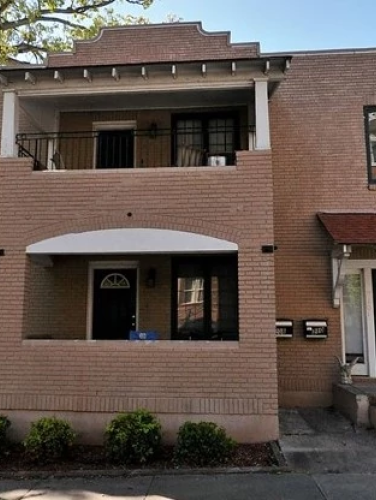
Woodlawn Avenue Duplex
(ca. 1926-1929)
The Woodlawn Avenue Duplex is a rare example of an early twentieth-century uptown Charlotte multi-family dwelling.
208 & 210 South Irwin Ave, Charlotte, NC 28202
The Woodlawn Avenue Duplex is a well-preserved example of a small two-story duplex, once a common component of Uptown’s early twentieth-century residential landscape but now among the rarest of historic building types. In fact, this duplex is one of the few surviving buildings of Woodlawn, one of Charlotte’s earliest (and smallest) streetcar suburbs. Once largely residential, the city’s urban core now contains a much-reduced collection of historic residential buildings. As the result of trends ranging from the streetcar suburbs of the early 1900s to the Urban Renewal campaign of the 1960s and 1970s, entire residential neighborhoods near the city’s urban core – including Brooklyn, Blandville, Trade and Tryon Streets, and First Ward – have been obliterated.
Property Quick Links
Some exterior neighborhoods originally linked to Uptown by the expanding streetcar systems, like Myers Park, Wilmore, and Washington Heights, have survived. But others, like Oakhurst (now in Plaza Midwood), Piedmont Park (now part of Elizabeth), and Woodlawn (now part of Irwin Park or Third Ward), were absorbed into larger neighborhoods, losing their distinct historic identities.
Woodlawn resulted from a decision by the Continental Manufacturing Company to develop its surplus Third Ward land into a residential neighborhood. Development began around 1907. Although located inside one of the city’s original four wards, Woodlawn was promoted as a suburb, perhaps due to the success of Dilworth as Charlotte’s first true streetcar suburb. Streetcar lines radiated out from the center of the city, prompting the development of smaller neighborhoods – like Woodlawn, platted along only four streets and served by the West Trade Street streetcar line – along those lines.
Built between 1926 and 1929, the Woodlawn Avenue Duplex was very much part of the “everyday” architecture of Charlotte’s urban core before World War II. Originally built as a white middle-class neighborhood, Woodlawn was dominated by blue-collar and lower-level white-collar workers for much of the twentieth century like Harry and Mary Fine who occupied the upper unit of the duplex (208 Woodlawn) in 1934. Harry worked as a clerk with the Southern Public Utilities Company (later known as Duke Power). Downstairs in 210 Woodlawn lived traveling salesman William Craig and his wife Frances. But the Woodlawn neighborhood consisted primarily of single-family houses. Woodlawn’s only other multi-family buildings were the adjacent quadraplex and the four-unit Woodlawn Terrace Apartments. More transitory than their neighbors who generally owned their homes, the duplex tenants changed rather frequently.
The Woodlawn Avenue Duplex continued to function as a duplex through the 1960s even as the nature of the neighborhood changed. Like most of Third Ward, Woodlawn saw an outflow of white residents as the city’s suburbs expanded. Facing a dwindling supply of housing in the city’s urban core, Black Charlotteans moved into the once segregated Woodlawn neighborhood. In the context of a vastly changed city, the Woodlawn Avenue Duplex remains an important artifact of Charlotte’s early twentieth-century residential nature.

